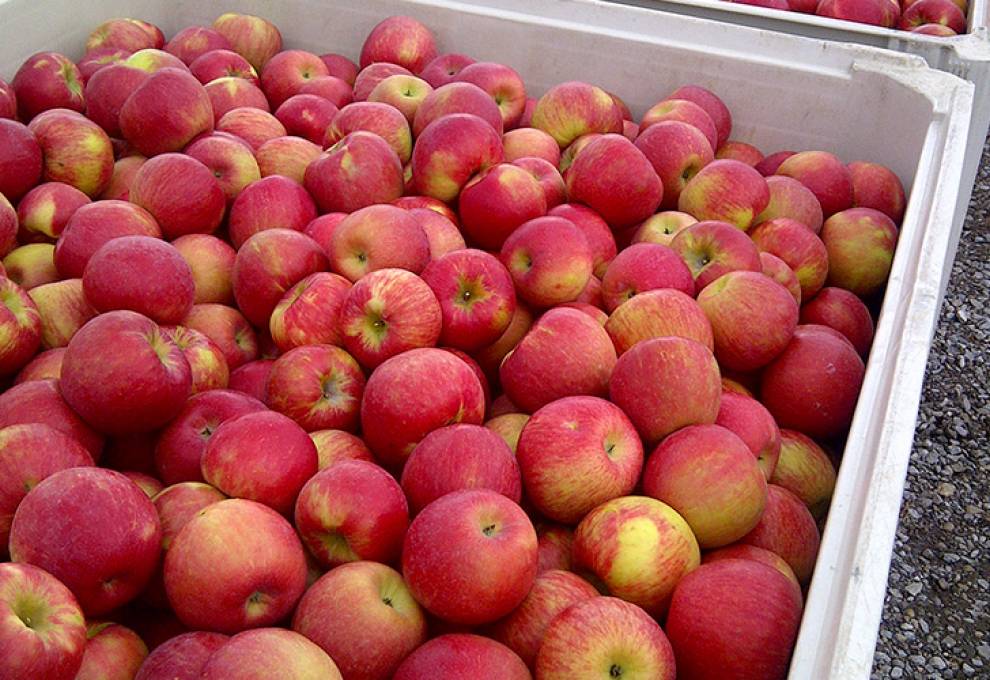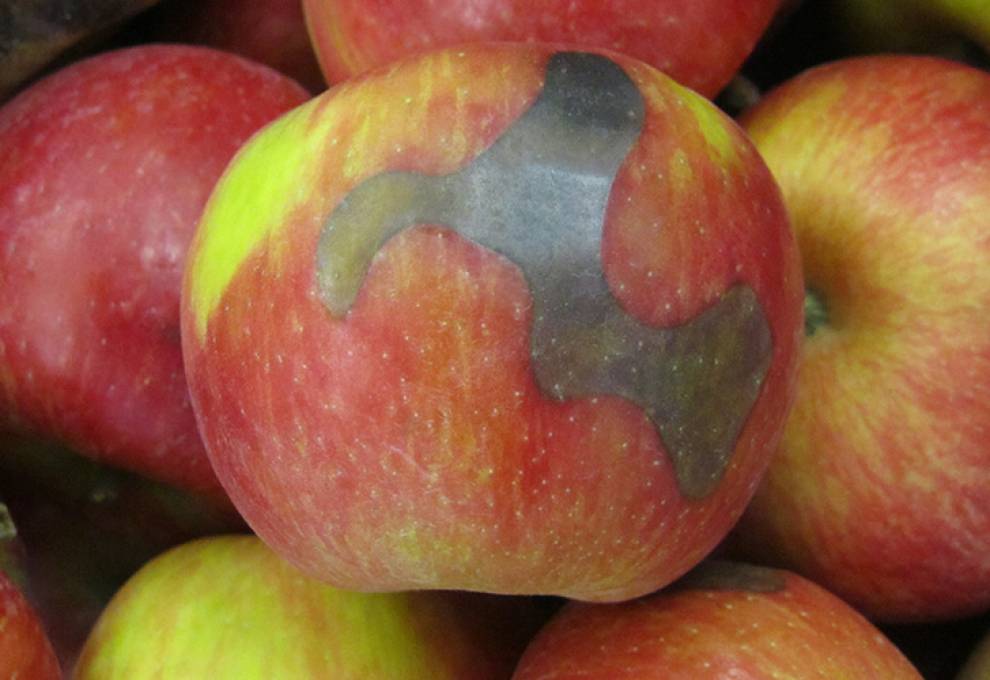

In recent years, there has been considerable advancement in understanding the finicky and complex ‘Honeycrisp’ apple. Postharvest practices to obtain good fruit quality, reduce physiological disorders and extend the storage life of ‘Honeycrisp’ are reviewed below.
Fruit maturity at harvest
Harvesting at optimum fruit maturity is extremely important for maximizing storage life and maintaining good apple quality. However, determining the optimum harvest maturity for ‘Honeycrisp’ is difficult. Standard maturity indices, such as internal ethylene concentration, starch index, soluble solids concentration and fruit firmness are not always consistent. Current recommendations suggest that harvest should occur when the ground colour begins to change from green to yellow and the starch index is around six (on the Cornell chart). There has been no consistent relationship of internal ethylene to harvest date and differences in maturity do not always exist among ‘Honeycrisp’ apples with varying levels of red colour. For example, brilliant red fruit can exhibit very similar internal ethylene concentrations, starch content, and firmness values as those
having poor red colouration.
Harvesting at optimum maturity is the best way to achieve the characteristic flavour of ‘Honeycrisp.’ Immature ‘Honeycrisp’ harvested too early will not ripen properly and those fruit do not develop good flavour and quality characteristics. Conversely, late harvested or over-mature ‘Honeycrisp’ can develop fermentation products, such as ethanol and acetaldehyde, which cause undesirable flavours and poor fruit quality. ‘Honeycrisp’ harvested at advanced maturity are also more prone to several major disorders.
In recent years, there has been considerable advancement in understanding the finicky and complex ‘Honeycrisp’ apple.
Physiological disorders
‘Honeycrisp’ is extremely susceptible to physiological disorders and there can be substantial variation among orchards and trees.
Soft scald is a major chilling-related disorder that can develop in ‘Honeycrisp.’ It is characterized by sharply defined, irregularly shaped, smooth, brown lesions of the skin. Peel tissue is initially affected and then hypodermal tissue is damaged as the disorder continues to develop. Skin lesions are often then invaded by secondary pathogens, such as Alternaria or Cladosporium. Soggy breakdown is another major chilling-related disorder that can be found in ‘Honeycrisp.’ It is distinguished by moist, soft, brown, spongy flesh tissue, which can form complete rings in severe cases. Both soft scald and soggy breakdown develop more in apples harvested at advanced maturity.
Senescent browning or diffuse flesh browning becomes more prevalent with extended storage durations and warmer temperatures. The fruit remains firm and there are usually no external symptoms. Advanced fruit maturity at harvest time also promotes this disorder.
Bitter pit may appear prior to harvest or during storage, and usually develops in the calyx end of the fruit. Pits are dark, sunken lesions at or beneath the fruit surface. The cause for bitter pit is a mineral imbalance in the apple flesh, associated with low levels of calcium.
Lenticel breakdown is characterized by darkened or black lenticels, or superficial small brown spots surrounding the lenticels. The lesions may become sunken over time and allow for the invasion of pathogens. Fruit with advanced fruit maturity are more susceptible, as well as those in long-term storage. The disorder can be aggravated by various chemicals and coatings.
Storage regimes
Prior to cold storage, conditioning at 10°C for one week is recommended to reduce the incidence of soft scald and soggy breakdown. Conditioning at warmer temperatures has been shown to substantially reduce acidity, which has also been noted within sensory evaluations. Bitter pit can develop more rapidly at warmer temperatures, so conditioning at 10°C is a compromise between bitter pit and soft scald development. After conditioning at 10°C for one week, ‘Honeycrisp’ is best stored in ambient air at 3°C.
Controlled atmosphere (CA) storage is not currently recommended for ‘Honeycrisp’ in Ontario. However, limited success has been observed using 3% O2 and 1-1.5% CO2 at 3°C. CA tends to substantially reduce greasiness, as well as maintain acidity. Severe internal browning can develop when ‘Honeycrisp’ is held in many of the standard or typical CA regimes used for other apple cultivars. ‘Honeycrisp’ tends to be very sensitive to CO2, so CO2-related disorders can easily develop (i.e. internal CO2 injury with or without flesh cavities). However, delaying the establishment of CA storage for four or eight weeks has been shown to reduce these disorders.
Postharvest treatments
Ethylene production, respiration, and greasiness can be reduced by 1-methylcyclopropene (1-MCP) on ‘Honeycrisp.’ 1-MCP tends to be slightly more effective when applied at the onset of the conditioning period at 10°C, compared to after that one-week period. However, always be aware of any CO2 accumulation during the 1-MCP treatment, as this has potential to cause CO2 injury. There is little loss of firmness in ‘Honeycrisp’ during storage, so any improved firmness retention caused by 1-MCP treatment is difficult to discern.
Diphenylamine (DPA) can reduce CA-related disorders in apples. DPA has been shown to reduce internal CO2 injury (with or without flesh cavities) in ‘Honeycrisp’ stored in CA.
Acknowledgements
Thanks to the Ontario Apple Growers, Apple Marketers’ Association of Ontario, Les producteurs de pommes du Québec, AgroFresh Inc., and Storage Control Systems Inc. for their support; as well as to Norfolk Fruit Growers’ Association and Pommes Philip Cassidy Inc. for their direct collaboration. Recent work pertaining to ‘Honeycrisp’ storage has been funded in part through Growing Forward 2, as part of the Canadian Agri-Science Cluster for Horticulture 2 and the Agri-Innovation program in
partnership with Agriculture and Agri-Food Canada and the Canadian Horticultural Council.

Add new comment